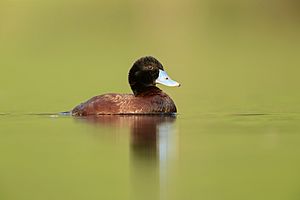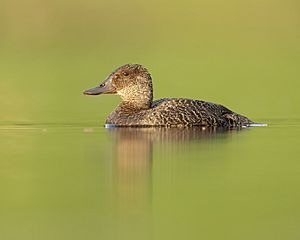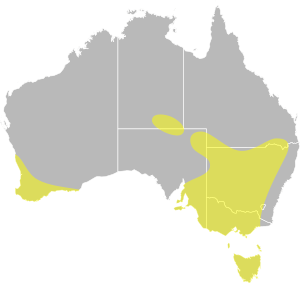Blue-billed duck facts for kids
Quick facts for kids Blue-billed duck |
|
|---|---|
 |
|
 |
|
| Conservation status | |
| Scientific classification | |
| Genus: |
Oxyura
|
| Species: |
australis
|
 |
|
| Range of Oxyura australis | |
The blue-billed duck (Oxyura australis) is a small Australian duck. It's known for its stiff tail and the male's bright blue bill during breeding season. Both male and female ducks grow to about 40 centimeters (16 inches) long.
Male blue-billed ducks have a dark chestnut body during breeding season, which turns dark grey later. Their bill changes from slate-blue to a bright blue. Females have black feathers with brown tips all year round.
These ducks live only in Australia's temperate regions. They prefer natural wetlands and even artificial ones like sewage ponds. It can be tricky to spot them because they are very shy, especially during their breeding season in autumn and winter. The male duck has a special dance to attract a mate.
Blue-billed ducks eat both plants and small animals. They especially like small creatures that live in water. This species is classified as "Near Threatened" by BirdLife International. This means their numbers are getting low, and they need protection.
Contents
What is the Blue-billed Duck?
The blue-billed duck was first described in 1836 by a bird expert named John Gould. Its scientific name, australis, comes from a Latin word meaning "southern," which makes sense because it lives in Australia.
How to Identify a Blue-billed Duck
Blue-billed ducks have unique tail feathers that are thick and spine-like. They usually hold their tail flat on the water. But they can also hold it straight up when they feel threatened or when the male is trying to impress a female. Their feet are very strong, which helps them swim and dive well. These ducks sit quite low in the water compared to other ducks.
Male Ducks
During the breeding season, the male's bill turns a bright blue. His head and neck are shiny black, and his back and wings are a rich chestnut color. When it's not breeding season, his head becomes black with grey spots, and his body changes to dark grey. Some males keep their breeding colors all year.
Female Ducks
The female's colors don't change. Her head is dark brown. Her back and wings have black feathers with light-brown tips, making her look mottled or speckled. Her bill is dark grey-brown, and her feet are grey-brown. Both male and female ducks have brown eyes.
Young Ducks
Young blue-billed ducks look a lot like the adult females. However, they are usually paler and have a grey-green bill.
Where Do Blue-billed Ducks Live?
The blue-billed duck lives only in the temperate parts of Australia. You can find them from southern Queensland, through New South Wales and Victoria, all the way to Tasmania. They are also common in the southwest of Western Australia. They don't often appear on the New South Wales coast unless there's a drought. They are most common in the Murray-Darling Basin.
These ducks almost always stay in the water. While they can walk on land, they find it difficult and waddle like penguins.
When they are not breeding, many ducks gather in large groups, sometimes hundreds of them. These groups, especially of younger ducks, stay in open lakes or dams during autumn and winter, far from the shore. During the breeding season, blue-billed ducks prefer deep, freshwater swamps. These swamps have lots of thick plants like cumbungi. They have also been seen in large rivers and even salty water bodies like billabongs.
How Do Blue-billed Ducks Behave?
The behavior of the blue-billed duck changes depending on whether it's breeding season or not.
During winter, when they are not breeding, the ducks gather in large groups on lakes. They also fly more often, probably because they are in open areas and can fly away from danger.
When they are breeding, blue-billed ducks are very secretive and careful. If they feel threatened, they will quickly and quietly dive underwater. They will then pop up far away instead of flying off. Blue-billed ducks have a quiet quack that you don't hear very often.
Courtship and Mating
The male duck has a very fancy and detailed courtship ritual. This includes actions like rolling his cheek on his back or throwing his head into the water. After this special dance and a fast chase, the male and female mate, with the female completely underwater. Then they separate and clean their feathers. The female builds the nest to lay her eggs. At this point, the male usually leaves her.
What Do Blue-billed Ducks Eat?
Blue-billed ducks are omnivores, meaning they eat both plants and animals. They eat seeds, buds, and fruits from water plants. They also eat small creatures that live in the water. The duck feeds underwater by sifting mud with its beak.
They especially like small invertebrates, which are animals without backbones. These include snails, water insects like midge larvae, caddis flies, dragonflies, and water beetle larvae. They can stay underwater for about 10 seconds while they are eating.
How Do Blue-billed Ducks Reproduce?
Some blue-billed ducks move from their breeding swamps in inland New South Wales to the Murray River during autumn and winter. However, many adult ducks stay in their breeding swamps all year. They breed whenever there is enough water and food, not just at certain times of the year.
A female duck usually lays between 3 and 12 eggs, but most often 5 or 6. If there are many eggs in one nest, it might mean two females laid eggs there. Sometimes, a female will lay her eggs in another duck's nest, which is called "facultative parasitism." They might even lay eggs in the nests of other water birds.
The eggs hatch after 26 to 28 days. The young ducks stay in the nest for one day, then the female leads them away. The young ducks are quite independent and can feed themselves right away. The female will protect all the young ducks in her brood, even those from other females. At 8 weeks old, ducklings are about the same size as their parents. Most young ducks have their full adult feathers within one year.
Protecting the Blue-billed Duck
Two main things are causing problems for the blue-billed duck:
- Changes to wetlands: People drain wetlands, control floods, and collect water, which reduces the places ducks can live.
- Loss of plants: Land clearing, too much grazing by cattle, and salty soil also destroy their habitat.
To help the blue-billed duck, environmental groups are working to keep water flowing naturally in wetlands. They are also creating plans to manage salty soil and improve farm management.
It's estimated that there are about 12,000 blue-billed ducks in Australia. However, many of these ducks live in artificial wetlands like water treatment plants. This can make it seem like their numbers are higher than they are in natural wetlands.
The blue-billed duck is no longer listed as "vulnerable" under a national environmental law in Australia. But it is still considered "vulnerable" in New South Wales and "threatened" in Victoria.
Why are Blue-billed Ducks Important?
The number of waterbirds in an area can tell us how healthy a wetland ecosystem is. If bird numbers go down, it's a warning that the natural balance of the freshwater system is in danger.
Blue-billed ducks are good indicators of wetland health because they can breed all year round if they find suitable habitats, even during droughts. So, if their population decreases over a long time, it's likely due to habitat loss from things like salty soil or too much grazing, rather than just natural drought cycles.
Images for kids
-
Adult Male at Lake Monger in Western Australia
-
Adult Male in Perth Zoo
See also
 In Spanish: Malvasía australiana para niños
In Spanish: Malvasía australiana para niños




